Using Page and Field Configurator
Page and Field Configurator gives users the flexibility to configure fields and pages in any component without having to customize delivered application pages or fields.
To configure any component using Page and Field Configurator, use the Page Configuration (EOCC_CONFIGURE), User Lists (EOCC_CONFIG_USER) and Map to Portal registry (EOCC_MAP_EVENT) pages.
|
Page Name |
Definition Name |
Usage |
|---|---|---|
|
EOCC_CONFIGURE |
Use this page to capture the page and field configuration and criteria. |
|
|
EOCC_CONFIG_USER |
Use this page to capture the list of users and/or roles to which the configuration defined on the Page Configuration page should be applied to or excluded from. |
|
|
EOCC_MAP_EVENT |
Use this page to map the configuration to the Portal Registry. |
|
|
EOCC_ADVANCED_TAB |
Use this page to select the fields that should be available in the field list or as criteria. |
|
|
EOCC_CONFIG |
Use this page to verify the validity of the configurations defined using the Page Configuration page. |
Use the Page Configuration page (EOCC_CONFIGURE) to define the changes needed for the component.
Navigation:
This example illustrates the Page Configuration page (1 of 2).
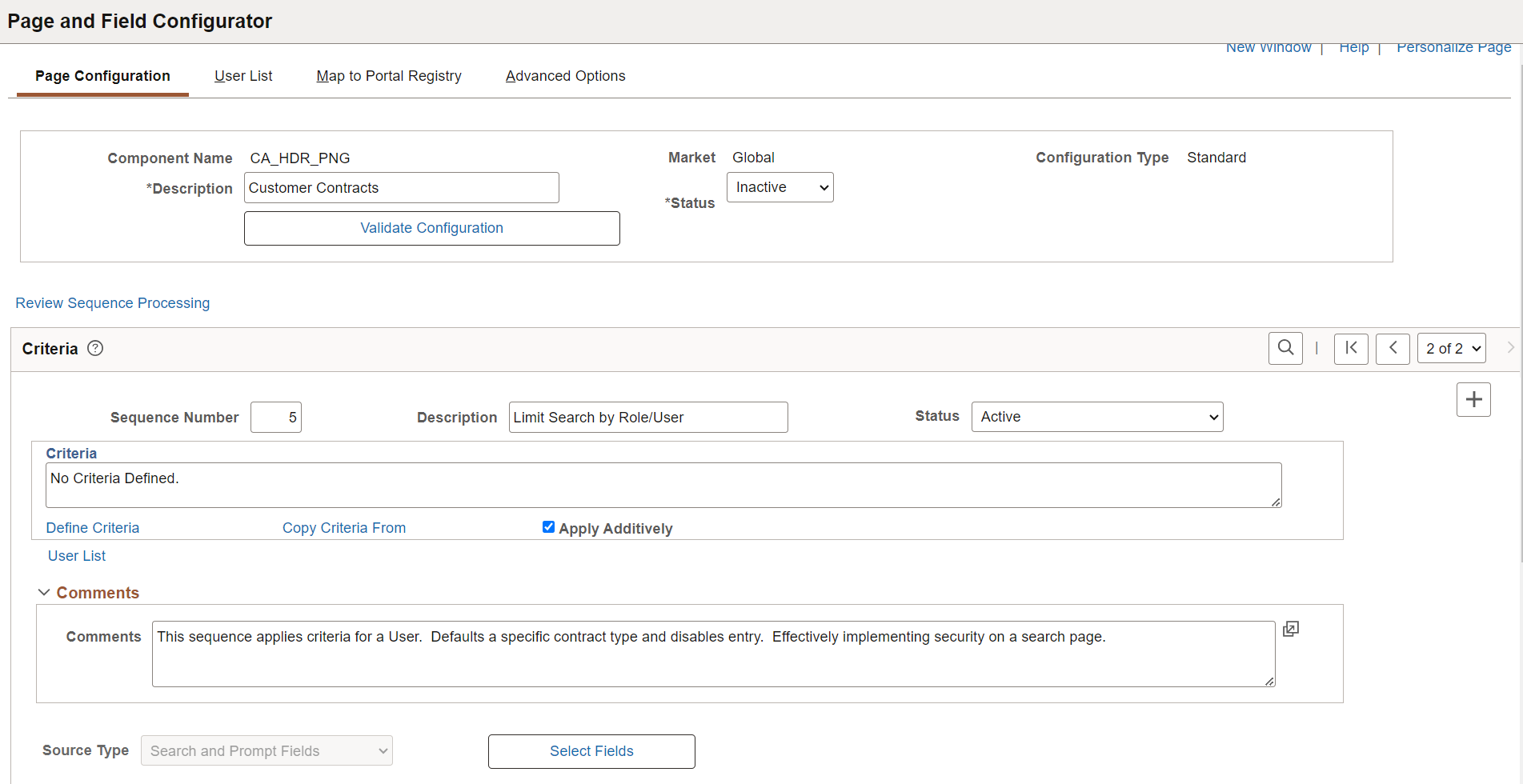
This example illustrates the Page Configuration page (2 of 2).

Field or Control |
Description |
|---|---|
Component Name |
Displays the name of the component as selected by the user. |
Description |
Enter an appropriate description. |
Market |
Displays the market for which the configuration is defined as selected by the user. |
Status |
Select the status of the configuration. |
Configuration Type |
Displays whether this is a Standard, Masking or Change Tracking configuration. |
Validate Configuration |
You can use the Validate Configuration button to verify the configuration against the underlying page metadata and identify if any errors exist. For more information, see Validate Page Configurations Page. |
Review Sequence Processing
Use the Review Sequence Processing link at the beginning of the Criteria section to review the list of sequences. Here you can see the sequences which are applied additionally.
This example illustrates the Review Sequence Processing page listing all the sequences.

Criteria
You can associate criteria with each configuration. In this section, you can capture the criteria for the component with sequence number.
|
Field or Control |
Description |
|---|---|
|
Sequence Number |
Enter the Sequence number for the configuration. Multiple configurations can be defined for same component and the sequence number is given to distinguish these configurations. Note: At the application run time, if the transactions satisfies more than one criteria defined in the configuration, then the criteria with lowest sequence number is selected for execution and the rest of the criteria and related configuration are ignored. However it works differently if Apply Additively check box is selected. For more information, see the Apply Additively section in this page. Please do not use sequence numbers from 900 and higher. These are reserved by Oracle. Note: Larger components and components with more than 100 configurations may take longer to evaluate and process at run time and result in delays in the online rendering of pages to the end user. |
|
Description |
Enter an appropriate description. |
|
Status |
Select the Status of the Sequence. |
|
Criteria |
Displays the criteria defined by the user using the Define Criteria or Edit Criteria hyperlink in a readable format. |
When you create a new configuration, Define Criteria link will be displayed on the page. On clicking the link you can select the fields available on the level zero or level one of the component, an operator, and enter a value to be compared at the run time, per Sequence Number.
This example illustrates the Define Criteria page.
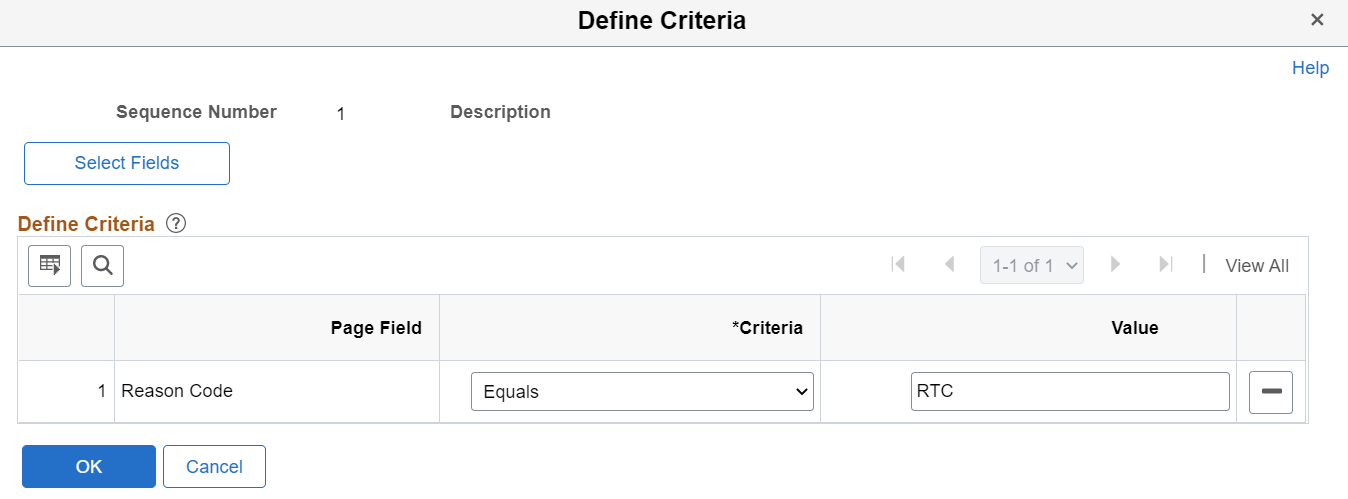
This example illustrates the Define Criteria page when a system variable is selected for defining criteria.

For an existing record, Edit Criteria link will appear where you can edit the criteria details. You can add a new row to add more than one condition (Field, Criteria and Value combination) for the same sequence level using the Select Fields button.
You can define criteria based on page name and field name. Once you select the page field, select the condition and enter the required value.
|
Field or Control |
Description |
|---|---|
|
Select Fields |
Use the Select Fields button to open the Select Field page. Here, you can select the field or system variable for defining criteria. By default, the Select Fields page lists the available fields based on the selected Primary Page. To view the list of available system variables, select System Variable in the Field Source field. |
This example illustrates the Select Field page when Page Fields is selected as the Field Source.

This example illustrates the Select Field page when System Variable is selected as the Field Source.
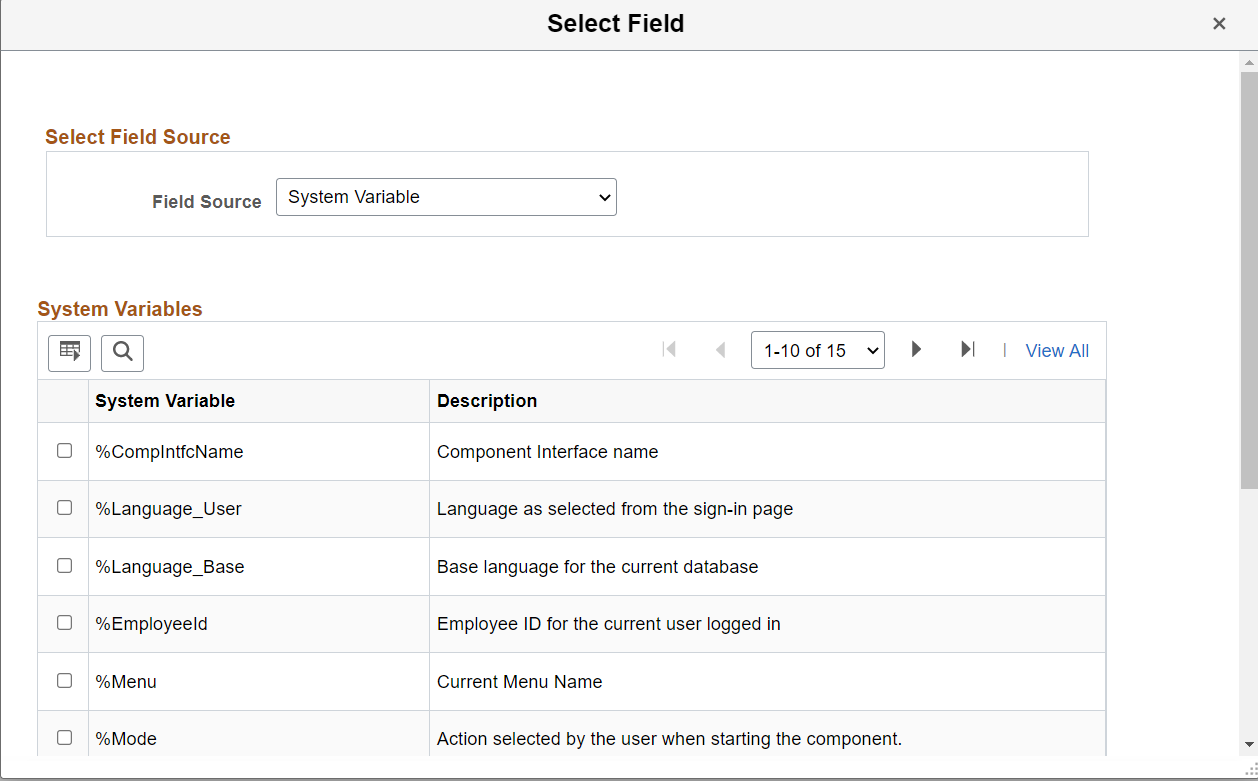
For example, you can use the Current System Date as criteria to determine whether to apply a configuration. To set a date to activate a configuration, select the system variable’ %Date’ in the Page Field and enter the required date in the Value field. The configuration takes effect based on the date defined.
|
Field or Control |
Description |
|---|---|
|
Page Field |
The field /system variable selected in the Select Fields page is displayed here. |
|
Criteria |
Select the condition for defining criteria. |
|
Value |
The value specified here is compared to the value in the Page Field. You can enter a value or select a system variable. |
|
Select System Variable |
Use this field to select a system variable in the Value field. Video: Image Highlights, PeopleSoft HCM Update Image 40: Page and Field Configurator - System Variables |
Note: While defining the criteria, the selected field should contain a value either from defaults or from existing transaction data. If criteria is configured on work record fields where data is populated dynamically, then at the time of criteria evaluation (Post Build event) if the system does not finds a value for the field, the criteria would fail and the configuration will not get applied.
The criteria will be evaluated at the time of component load and reevaluated when a field used as criteria is modified by the user or when a row is inserted.
|
Field or Control |
Description |
|---|---|
|
Copy Criteria From |
You can use this link and select a sequence number from which you can copy the criteria. |
|
User List |
Click the link to open the User List page. Use this page to quickly create corresponding sequence level user list for the configuration. For more information see,User List Page. |
Note: If field in the criteria is set to deferred processing, then PFC will not recalculate the criteria when this field is modified by user. It would be processed only when there is another Application server trip like, adding a new row, switching tabs etc.
Apply Additively
Use the ‘Apply Additively’ check box when you want multiple sequences to impact the page viewed by the user. The component configuration is evaluated as follows:
The system evaluates sequences and their criteria in ascending order starting with sequence 1.Once the Page and Field Configurator finds a match in criteria (this could be sequence 1 or a later sequence and may have the ‘Apply Additively’ box selected or not selected), the system proceeds to evaluate only the later sequences that are marked as ‘Apply Additively’.
Note: For a configuration sequence to be applied and impact the page viewed by the user, the criteria for the sequence must be met. Selecting the ‘Apply Additively’ check box ensures that the sequence and its criteria will always be evaluated and if met, will be applied to the page viewed by the user in addition to other sequences.
As an example, assume sequences 1 through 4 are not applied additively, but sequences 5 through 10 are selected to apply additively. The system starts evaluation with sequence 1 and proceeds in ascending order. Assume sequence 1 and 2 criteria are not met, but sequence 3 criteria is met. The system would apply sequence 3 configuration then move to evaluating any subsequent sequences marked as Apply Additively. Sequence 5 would be evaluated next and if criteria is met, would be applied in addition to sequence 3. Sequence 4 would not be evaluated. Sequences 6-10 would also be evaluated for criteria since all are marked as Apply Additively. The display shown to the user would include all the sequences where criteria was satisfied.
If the same field is being modified in multiple sequences then both sequences will be applied. For example if a field in a sequence is marked as Disable Entry in one sequence and in another sequence which is applied additively it is marked as Modify label, then on applying the configuration that field will have the label modified as well as its text area disabled.
If a property of a field is modified on multiple sequences, then the property in the highest sequence gets applied. For example if for a field in sequence 1 you modify the label as abc and for the same field in sequence 6 you modify the label as xyz, then on applying the configuration, the label xyz will take effect.
Note: Once a field has been set as disabled for entry, required for entry or hidden, then it cannot be undone in a subsequent sequence. Only labels and default values can be changed in subsequent sequences.
Masking configurations are applied after standard configurations. Masking configurations are applied additively.
Source Type
Use the source type selection to specify the types of fields configured in the sequence: Page Fields or Search and Prompt Fields.
The records available for the Search Record include the delivered search record for the component and any user configured search records in Configurable Search that are active.
Since Search Fields and Prompt Fields can share the same configuration sequence, the check boxes available at the row level in the grid will depend if the field is from the search record, add record or prompt
The record type (for example, Search Record or Prompt Record) appears in the Record Type column within the Technical Details tab.
Select Fields
Click the Select Fields button to open Select Field page. You can use this page to select an existing field from the component.
Note: Radio buttons and non-data entry fields will not be available for selection in the list.
Be cautious while selecting fields on a grid or scroll area which can contain large volume of data as it could result in the performance degradation of the component.
You can select multiple fields from a primary page or from the secondary page of a primary page.
This example illustrates the Select Field page.

Field or Control |
Description |
|---|---|
Primary Page |
Choose the main page. |
Secondary page |
Choose the secondary page listed under the selected primary page. |
Restrict to Fields from Advanced Options |
Select the check box to display only the selected fields from Advanced Options tab. Once selected, the ‘Page Fields’ grid lists only the fields from Advanced Options page with ‘Include in Criteria List’ or ‘Include in Field List’ check boxes selected . |
Choose the fields to be configured from the list of page field results. Use ‘Select all Fields’ button to select all the fields from the page for configuration.
Device Form Factor
Select the device form factor using the given check boxes. The options are:
Small
Medium
Large
Extra Large
Comments
You can specify any additional comments here.
Configure Field Properties
The Configure Field Properties section consists of two tabs, General Information and Technical Details. This section is used to capture the field level changes that need to be made for a component.
This example illustrates the General information tab

|
Field or Control |
Description |
|---|---|
|
Field Name |
Based on the selected field, name of field is displayed. |
|
Label Text |
Label of the field is displayed based on your selection. Note: This field is enabled only if ‘Modify Label’ check box is selected. |
|
Modify Label |
Select the check box if you need to modify the label. |
|
Hide Field |
Select the check box if you need to hide the field. Note: You can only hide the fields which are visible in the application designer. The fields made invisible in application designer cannot be made visible via configuration. |
|
Disable Entry |
Select the check box if you need to make the field as read-only. Note: You can disable a field only if it is by default editable in the application designer. The field which is already disabled in application designer or people code could not be made editable using the configuration. |
|
Set Value to Blank |
Select the check box if you need to leave a specific field blank when it is disabled or hidden through PFC. Note: The ‘Set Value to Blank’ can be checked only if ‘Hide Field’ or ‘Disable Entry’ is selected for that field. Also, ‘Set Value to Blank’ can be used only if the sequence has criteria. For example, you need to restrict users from entering any value for a field and the value in the field should appear as blank. Then, you should select ‘Disable Entry’ and ‘Set Value to Blank’. Note: Once ‘Set Value to Blank’ is selected for a field in Page and Field Configurator page, any previously entered data in the field will be cleared. |
|
Required Field |
Select the check box if you need to make the field as mandatory. Note: You can make a field mandatory which is not configured as required in the application designer. The field which is made as required in application designer or people code could not be made Not-Required by using the configuration. Also, the Required Field selection should not be used on fields that are displayed as a Yes/No checkbox or slider. These fields will always have a value. For required fields, the validation is executed during the component SavePreChange event. If the SavePreChange event is not called in certain components, then the required fields will not be validated in those components. |
|
Default Value |
Enter a value if you need to add a default value for the field. Note: The default value will be applied only when the component is opened in Add mode or when a new row is inserted. Default values should not be used on fields that already have a default through the application. The Page and Field Configurator will not override a default created through the delivered application pages. The system will not do any check on the value entered on this field except for the basic format check. Be cautious while entering the default value as a non-acceptable value throws an error at the run time of the selected component. You should not default a value for a field that already has additional processing associated with it such as field change. |
|
Select System Variable |
Use this button to select a system variable as the default value for a field. Click the icon to open the Select System Variable page. |
Select System Variable Page

The selected value appears in the Default Value field. Page and Field Configurator uses a subset of system variables available through PeopleTools, and the variables available to use as Default are different from those available as Criteria. For more information on system variables in PeopleSoft, see PeopleTools: Products, Development Tools, PeopleCode Language Reference, System Variables.
Click the Technical Details tab on the Page Configuration page.
This example illustrates the Technical Details tab.

|
Field or Control |
Description |
|---|---|
|
Field Name |
Based on the selected field, name of the field is displayed. |
|
Record Name |
Record (table) name of the selected field is displayed. |
|
Page Name |
Page name of the selected field is displayed. |
|
Occurs Level |
Occurs level indicates the level of the selected field. |
You can use Copy Field Properties From link and select a sequence number from which you can copy the field properties.
Configure Page Visibility
The Configure Page Visibility section is used to hide or show an entire page in the component. It also has the capability to make a page as display only.
Field or Control |
Description |
|---|---|
Page Name |
Select the page that needs to be configured. |
Visible |
Select from the following options:
Note: If all the pages of a component are selected as invisible either via the configuration or via the Application Designer or through a combination of both, then the system may behave unexpectedly as there should be at least one page visible for the component. |
Display Only |
Select the check box to make the selected page as read only at the component run time. Note: A page which is already Display Only in Application Designer or PeopleCode could not be made editable by using the configuration. Pages cannot be hidden if the sequence criteria includes a level one field. System prompts you with a warning, if you have made any field as Required Field in the configuration and if the page where the field appears is configured as Display Only or Invisible. |
Page Visibility feature is supported for all classic components and selected fluid components. Only the fluid components with left panel and side page with group box of type” Page Tab” are supported. For more information on side pages, refer the product information PeopleTools: Providing Left Navigation Using PT_SIDE_PAGETABS
Use the User List page (EOCC_CONFIG_USER) to define the list of users to whom the configuration needs to be applied. You can create user list at Header Level where one user list covers the entire component or, at Sequence Level, where separate user list is defined for each sequence number.
Navigation:
Enterprise Components, Page and Field Configuration, Page and Field Configurator, User List
This example illustrates the User List page.

Field or Control |
Description |
|---|---|
Level |
The user list can be applied either on the Header Level or on the Sequence Level.
|
Applies To |
Select from the following options:
|
Role |
Select the role to which the configuration needs to be applied. |
User ID |
Select the User ID of the users to which the configuration needs to be applied if ‘Applies To’ is selected as ‘Selected Users’. When the ‘Applies To’ is selected as ‘All Users with Exception’ or ‘Selected Role with Exception’, the User ID will correspond to the User to which this configuration need not be applied to. Note: When the ‘Applies To’ is selected as ‘Selected Users’, the grid Excluded Users will be replaced with User List grid. |
Use the Map to Portal Registry page (EOCC_MAP_EVENT) to map the configurations to Portal Registry. The defined configuration will be effective only when the Services defined by the utility are mapped to the corresponding portal registry entries.
Note: Access to this page is restricted based on the access to People Tools Events Mapping component.
Navigation:
Enterprise Components, Page and Field Configuration, Page and Field Configurator, Map to Portal Registry
This example illustrates Map to Portal Registry page with Standard configuration.

This example illustrates Map to Portal Registry page with Change Tracking configuration.
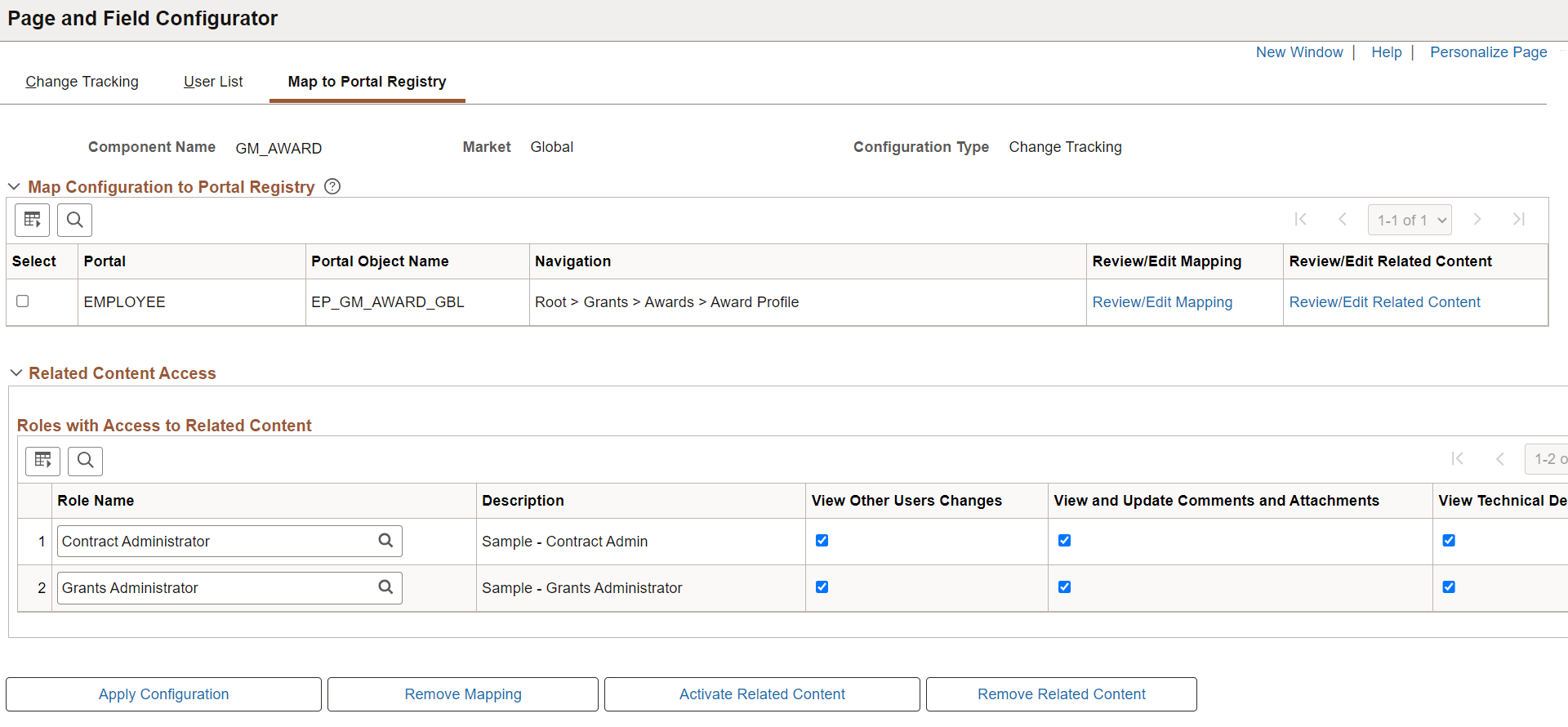
At the time of page save, if any potential errors in configurations are detected, the system will issue a warning message to the user stating the reason. However it is left to the user to take the final action to proceed with the configuration.
Note: During the process of mapping the configurations, if the system faces any exceptions, the system prompts the user to generate the Event Mapping manually.
If any changes are made to the configuration, the Page and Field Configurator services need to be mapped again to the portal entry using the Apply Configuration push button.
Map Configurations to Portal Registry
|
Field or Control |
Description |
|---|---|
|
Select |
Select the required portal registry entries to map the configuration. |
|
Apply Configuration |
Once you have selected the portal registry for mapping, click Apply Configuration button. If it is an existing configuration, system re- creates the configuration after removing the existing one. The system issues appropriate warning message to notify the user about the same. |
|
Remove Mapping |
Use this button to clear the Event Mapping configurations defined earlier. |
|
Activate Related Content |
Click Activate Related Content button to activate the Related Information frame (Fluid pages) or the Related Content drop-down (classic pages) to view the change history for the transactions. To know more about the example of Related Content page for Fluid and Classic components, see Related Content section below. |
|
Remove Related Content |
Use this button to clear the Related Content configurations defined earlier. |
|
Review/Editing Mapping |
Click this link to review/edit the mappings generated by the Page and Field Configurator on the Event Mapping page delivered by People Tools. For more information on Editing the Event Mapping, see Configuring the Event Mapping Manually Note: The Review/Editing Mapping link will be visible only if the Page and Field Configurator services are mapped to the corresponding portal entry. |
|
Review/Edit Related Content |
Click this link to configure Related Content, related action, and layout. For more information, see Assigning Related Content to Classic Components and Pages (PeopleTools, Configuring Related Content, Related Actions, and Menu and Frame Layouts). Note: The Review/Edit Related Content link will be visible only if the Page and Field Configurator services are mapped to the corresponding portal entry. |
Related Content
Following are the examples of Related Content page for Fluid and Classic components.
This example illustrates the fields and controls on the Related Content Fluid page - Review Change Summary. You can find definitions for the fields and controls later on this page.

|
Field or Control |
Description |
|---|---|
|
Filter |
Use the filter option to refine the change summary by field name, date, user, and change type. |
|
Date Time |
Displays the date and time of change. |
|
Changed Field |
Displays the name of the fields that are updated. |
|
Change Type |
Displays what type of changes are made:
|
|
New and Previous |
Displays the new value and previous value of the fields |
|
User |
Displays the user who made the change. |
|
Additional Information |
Displays the key values for the record that was changed. If this is blank then the key values match the information displayed at the top of the window. |
 and  |
Click to view, add, or delete comments and attachments to the change row. The number in the attachments column displays the number of attachments added to the change line. |
|
Technical Details |
Click to view change tracking technical details like record, field, and record keys names. |
This example illustrates the fields and controls on the Related Content Classic page - Review Change Summary.

Additional Options
|
Field or Control |
Description |
|---|---|
|
Enable Page Level Events |
Select this checkbox to enable mapping of Page and Field Configurator to Page Activate people code events. Once the page level events are enabled, the field configurations defined on the Page Configuration tab will preside over any application delivered Page Activate event people code. Note: By default this will be enabled for fluid components. |
Related Content Access
Use this section to grant role-level access to change tracking related information on the selected component. Users assigned to the role can view a history of changes for the transaction as related content.
You define the field-level tracking using the Change Tracking Page.
When enabled, users can view transaction history using the Related Information frame (Fluid pages) or the Related Content drop-down (classic pages). Related information displays the field that changed, the date of the change, the user who made the change, the new value, and the prior value.
Entry Mode is also tracked and displayed as related content if the component uses correction functionality. If the fluid component uses correction functionality it is displayed when you have PeopleTools 8.60 or higher installed.
Note: This section is only visible with Change Tracking configuration.
|
Field or Control |
Description |
|---|---|
|
Role Name |
Enter one or more roles that can access the related content. |
|
Description |
Displays the role description. |
|
View Other Users Changes |
Select this check box to allow the role to view field-level changes made by other users. |
|
View and Update Comments and Attachments |
Select this check box to allow the role to view and update comments and attachments related to the change. |
|
View Technical Details |
Select this check box to allow the role to view technical details associated with the field-level change, such as record key details. |
Use the Advanced Options page (EOCC_ADVANCED_TAB) to streamline the selection of fields on other pages in the Page and Field Configurator. On the Advanced Options tab, you can select the fields that should be available in the field list or as criteria. For complex components with a large number of fields to choose from, you can select the fields available to use on the Advanced Options tab as a one-time activity. The PFC user can filter their search results to the list of fields on the Advanced Options tab, saving the functional PFC user’s time from having to sort through a long list of fields or as criteria.
Note: The Advanced Options tab is targeted for use by technical resources familiar with the structure of the component's data. Only technical resource can modify the Advanced Options page. The page will appear as read-only to others.
This page is not available when using the Change Tracking configuration.
|
User Role |
Page Name |
|---|---|
|
EOCC Technician |
Advance Options Page |
Navigation:
This example illustrates the Advanced Options page.

Field or Control |
Description |
|---|---|
Component Name |
Displays the name of the component as selected by the user. |
Market |
Displays the market for which the configuration is defined as selected by the user. |
Load Fields for Use
Use this button to open Select Field page and select the fields that need to be configured. On the page, you can search the required page based on Primary and Secondary page.
This example illustrates the Select Field page.
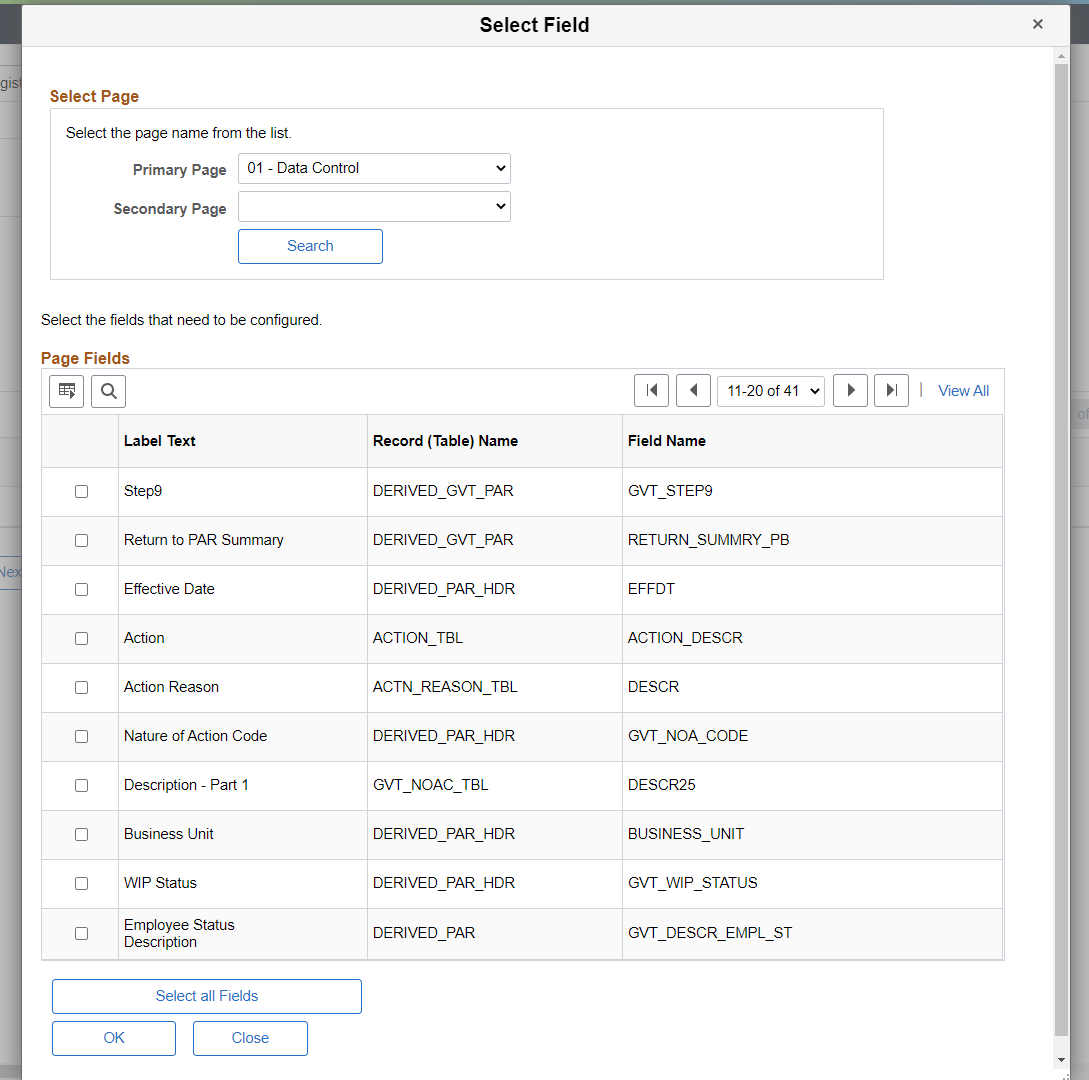
From the Page Fields grid, select the fields that need to be configured. On save, the selected fields get listed on the Page Configuration page.
Filter Result
Use the filter option to find a specific field already loaded on the Advanced Options page. You can filter the fields to be displayed in the ‘Fields Available for Configuration and Criteria’ grid based on Primary page, Secondary Page, Level, and Field Label.
Fields Available for Configuration and Criteria
Field or Control |
Description |
|---|---|
Page Name, Record (Table) Name, Field Name, Label Text, Occurs Level |
By default, values in these fields are displayed. |
Include in Criteria List and Include in Field List |
Select these checkboxes to include the field in the field list or criteria list when the 'Restrict to Fields from Advanced Options' check box is selected.
For example, if you select these check boxes for five fields, only those five fields will be listed when ‘Restrict to fields from Advanced Options’ checkbox is selected in Select Field modal. |
Use the Validate Page Configurations page (EOCC_CONFIG) to verify the validity of the configurations defined using the Page Configuration page. This component can be used to verify the validity of the configurations after any system update or application of fix or patch. Any changes to the page or page field meta data of the fields and pages selected in Page and Field Configuration will be reported as validation error.
Navigation:
Enterprise Components, Page and Field Configuration, Validate Page Configurations
This example illustrates the Validate Page Configurations page.
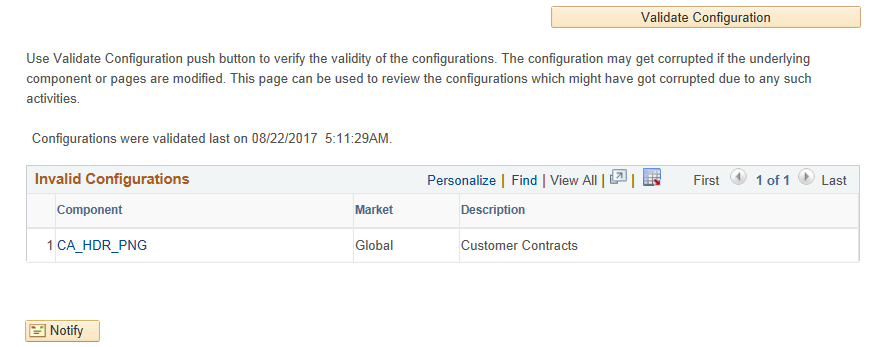
The Component listed in the Invalid Configuration section is a hyper link. Click the link to directly open the corresponding configuration.
The page and field configuration can be exported as ADS (Application Data Set) zip files and can be imported back to the desired database. The data set definition EOCC_CONFIGURATION can be used to export the configuration defined in one environment to another.
Note: The Data Set EOCC_CONFIGURATION will contain only the Page and Field related configurations. Any Event Mapping related configurations needs to be exported/imported separately using the corresponding ADS definitions. Alternatively, users can use the Apply Configuration push button on the "Map to Portal Registry" page to generate the Event Mapping configuration on the target environment."
See the product documentation for:
PeopleTools: Copying and Comparing ADS Projects
PeopleTools: Upgrading or Copying Related Content Data Using ADS Definitions
This topic discuss on configuring the event mapping manually.
Manual event mapping is required when the ‘Apply Configuration’ push button on the Map to Portal Registry page fails to map the events automatically or to handle other use cases not supported by Page and Fields Configurator as delivered.
The configuration can be mapped to each of the registered entity of the component using the Event Mapping page.
Navigation:
You can also use the link from the Map to Portal Registry page in Page and Fields Configurator.
On the Event Mapping page, create a mapping for the Record field (obtained earlier) in the ‘Component Record Field Level Event Mapping’ section.
This example illustrates the Event Mapping page.

For more information on the fields and controls on the Event Mapping page, see Mapping Application Class PeopleCode to Component Events in PeopleTools documentation.
Note: You may need to map the services manually only if you have other Services already mapped to the Component or if the system prompts you to do so. In all other cases you could map the services for the configuration using the “Apply Configuration” push button.
To map the events manually, follow the below guidelines:
Map the service EOCC_POSTBUILD to the PostBuild event (Component Level Event Mapping grid) of the component.
Map the service EOCC_SAVEPRECHANGE to the SavePreChange event (Component Level Event Mapping grid) of the component.
For all the fields selected in the configuration residing on a scroll level greater than zero of the component ( the fields on the grids and scroll areas), map the services EOCC_ROWINIT and EOCC_ROWINSERT to the Component Records (Component Record Level Event Mapping grid) RowInt and RowInsert events respectively.
For fields residing on scroll levels greater than 1 of the component, map the service EOCC_ROWINIT to the RowInit event on the Component Record (Component Record Level Event Mapping grid) for the primary records of its parent level up to level 1.
For example, if there is a component with four levels having primary records Record0, Record1, Record2, and Record3 respectively. For a configuration of any field on the Level 3, the RowInit events of its parent record Record2 and Record1 needs to be configured in addition to the RowInit and RowInsert events of the Record3.
The RowInit and RowInsert events should be mapped to the primary record of the scroll area. For example if the related display field in a grid is configured in the utility, the services need to be mapped to the grid’s primary record. It should not be mapped to the related field’s record.
If the PeopleTools version is 8.55 instead of using the services EOCC_ROWINIT and EOCC_ROWINSERT directly, the services should be cloned for each instance and the cloned instance should be used. The services can be cloned from the Define Related Content Service (Main Menu> PeopleTools> Portal> Related Content Service). The services can be cloned to any new names such as EOCC_ROWINIT_1, EOCC_ROWINIT_2 etc.
To override the page level PeopleCode, map the service EOCC_PAGEACTIVATE to the Page Activate Event (Component Page Level Event Mapping grid) for the required pages.
Select the Processing Sequence as “Post Process” for all the service configurations.
For Page and Field Configurator to work correctly on secondary pages, a Related Content Service needs to be manually mapped to the PushButtons/Hyperlinks to open the secondary page. When fields from secondary/Modal pages are used, map the service EOCC_SECONDARYPREPROCESS (for Standard) and EOCC_PREPROCESS_MASK (for Masking) to the event FieldEdit of the link/ button used to invoke the secondary page.
If a Page Field is populated after Component PostBuild, configurations may not work as expected. This may occur either for the Standard or Masking configurations. In this case, you should consider mapping the PostBuild Service (EOCC_POSTBUILD) to PageActivate event in Event Mapping Configuration for standard configuration and EOCC_MASK_POSTBUILD for Masking configuration.
Note: On save, if you get an error stating ‘Page Data is inconsistent with database’, reload the event mapping component and add the mapping again.